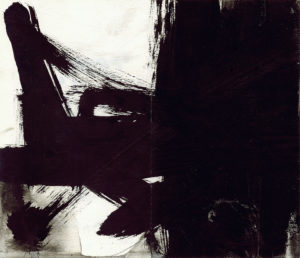PAINT IT BLACK
Note: What follows is the introduction to the essay, “Discovering the Influence of Joachim Probst’s Night Works on Franz Kline.” The full critical biography on Probst is in progress, and may be published later in 2022. Any questions, please contact us.
 Joachim Probst [1913–1980] was a notorious bohemian in Greenwich Village from 1936 to the mid 1970s. From the early 1940s onward, he fluidly pursued two styles in parallel. One style was the figurative expressionism in which he presented the Crucifixion and Biblical spectacles. His other style was completely non-objective, typically painted as black ink washes — which grew to become an extensive series he called the Night Works. The recent discovery of these latter works not only illuminate and enliven the history of modern painting but reveals Probst’s surprising influence upon a giant of Abstract Expressionism — Franz Kline.
Joachim Probst [1913–1980] was a notorious bohemian in Greenwich Village from 1936 to the mid 1970s. From the early 1940s onward, he fluidly pursued two styles in parallel. One style was the figurative expressionism in which he presented the Crucifixion and Biblical spectacles. His other style was completely non-objective, typically painted as black ink washes — which grew to become an extensive series he called the Night Works. The recent discovery of these latter works not only illuminate and enliven the history of modern painting but reveals Probst’s surprising influence upon a giant of Abstract Expressionism — Franz Kline.
Probst’s full story may have remained buried had his private journal not come to light. Even before his death in 1980 much of his life’s work had long been placed in storage by his three principal dealers. This discovery begins 2010 when one of his ink drawings was purchased online by Jeff Armstrong, retired from the insurance industry and living in Lenexa, Kansas. His inquisitive nature led him to an online forum where he was surprised to find an ongoing discussion about Probst. As his research progressed, a few years later he was contacted by one of Probst’s relatives. This proved to be a critical turning point because the collection contained, in addition to many artworks, a trove of ephemera, photographs, letters — and a private journal. In 1949 Probst titled his journal Secret Writings. When he made his last entry in 1978 he pasted down an end sheet with the title, The Black Book. This journal contains 779 pages, each being 10 x 7 inches. They are comprised of 537 full-page brush & ink washes, 33 pages with text with drawings, and 209 script-only pages. Starting in 1949 and through the 1950s, Probst’s spirited script references Kline seventeen times— often written with a homemade bamboo pen. Probst resolutely kept his journal private, not even sharing it with family members. It now serves as a primary source providing crucial insights, and Mr. Armstrong has kindly granted the author permission to reproduce certain quotes.

It is only with the unearthing of this journal that one gains Probst’s views on his peers in Greenwich Village, some of whom would later become famous. Among them were Jackson Pollock and Willem de Kooning. However, the painter with whom he formed the closest bond was Franz Kline. This compelling relationship has remained buried and unknown to contemporary historians of American art. The most thorough biography remains Harry Gaugh’s The Vital Gesture: Franz Kline (1985) — but there is no mention of Probst. The only testament of a connection between the two has been Probst I (1960), a large canvas by Kline in the collection of Museum of Fine Arts Boston. The museum’s description refers to Probst simply as “an artist friend from the Village.” Outside of a few octogenarians, no one had heard of Probst nor could recall his flirt with fame six decades ago. Now, this essay reveals a surprise to anyone interested in Abstract Expressionism. It has been abridged from the full critical biography on Probst to be published in the online art magazine Discoveries in American Art.
— by Peter Hastings Falk
